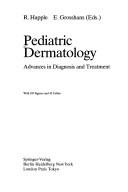| Listing 1 - 6 of 6 |
Sort by
|
Book
ISBN: 3642387640 3642387659 Year: 2014 Publisher: Berlin, Heidelberg : Springer Berlin Heidelberg : Imprint: Springer,
Abstract | Keywords | Export | Availability | Bookmark
 Loading...
Loading...Choose an application
- Reference Manager
- EndNote
- RefWorks (Direct export to RefWorks)
Mosaicism is a powerful biologic concept, originally developed from the study of plants and animals, and is the necessary basis for the explanation of numerous human skin disorders. This lavishly illustrated book presents, for the first time, a comprehensive overview of the strikingly manifold patterns and peculiarities of mosaic skin disorders. It is structured in a straightforward, reader-friendly way that will help the dermatologist to understand the underlying molecular mechanisms of skin disorders in order to further improve the treatment outcome. The first two parts of the book are devoted to the mechanisms and patterns of cutaneous mosaicism, with explanation of genomic and epigenetic mosaicism and description of the six archetypal patterns, including the lines of Blaschko, as well as less well defined or as yet unclassifiable patterns. In the third part, the various mosaic skin disorders are examined in depth, including nevi, allelic and non-allelic didymosis, other binary genodermatoses, mosaic manifestations of autosomal dominant skin disorders, and nevoid skin disorders. The book concludes with a note on neoplastic skin lesions, examining models of tumorigenesis.
Dermatology. --- Skin --- Diseases --- Molecular aspects. --- Diseases. --- Cutaneous diseases --- Dermatoses --- Cutis --- Integument (Skin) --- Medicine. --- Human genetics. --- Neurology. --- Ophthalmology. --- Pediatrics. --- Medicine & Public Health. --- Human Genetics. --- Medicine --- Dermatology --- Beauty, Personal --- Body covering (Anatomy) --- Eye --- Nervous system --- Neuropsychiatry --- Genetics --- Heredity, Human --- Human biology --- Physical anthropology --- Paediatrics --- Pediatric medicine --- Children --- Health and hygiene --- Neurology .
Digital
ISBN: 9783642387654 Year: 2014 Publisher: Berlin, Heidelberg Springer
Abstract | Keywords | Export | Availability | Bookmark
 Loading...
Loading...Choose an application
- Reference Manager
- EndNote
- RefWorks (Direct export to RefWorks)
Mosaicism is a powerful biologic concept, originally developed from the study of plants and animals, and is the necessary basis for the explanation of numerous human skin disorders. This lavishly illustrated book presents, for the first time, a comprehensive overview of the strikingly manifold patterns and peculiarities of mosaic skin disorders. It is structured in a straightforward, reader-friendly way that will help the dermatologist to understand the underlying molecular mechanisms of skin disorders in order to further improve the treatment outcome. The first two parts of the book are devoted to the mechanisms and patterns of cutaneous mosaicism, with explanation of genomic and epigenetic mosaicism and description of the six archetypal patterns, including the lines of Blaschko, as well as less well defined or as yet unclassifiable patterns. In the third part, the various mosaic skin disorders are examined in depth, including nevi, allelic and non-allelic didymosis, other binary genodermatoses, mosaic manifestations of autosomal dominant skin disorders, and nevoid skin disorders. The book concludes with a note on neoplastic skin lesions, examining models of tumorigenesis.
Paediatrics --- Human genetics --- Pathological dermatology --- Neuropathology --- Ophthalmology --- tumoren --- medische genetica --- hersenen --- dermatologie --- genetica --- pediatrie --- oftalmologie --- moleculaire biologie

ISBN: 3540169911 Year: 1987 Publisher: Berlin ; Heidelberg ; New York ; London ; Paris ; Tokyo Springer
Abstract | Keywords | Export | Availability | Bookmark
 Loading...
Loading...Choose an application
- Reference Manager
- EndNote
- RefWorks (Direct export to RefWorks)

ISBN: 3540509607 Year: 1990 Publisher: Berlin [etc.] Springer
Abstract | Keywords | Export | Availability | Bookmark
 Loading...
Loading...Choose an application
- Reference Manager
- EndNote
- RefWorks (Direct export to RefWorks)
Book
ISBN: 3540192220 Year: 1989 Publisher: Berlin : Springer,
Abstract | Keywords | Export | Availability | Bookmark
 Loading...
Loading...Choose an application
- Reference Manager
- EndNote
- RefWorks (Direct export to RefWorks)
Genetic counseling. --- Ichthyosis --- Ichthyosis --- Diagnosis. --- Therapy.
Multi
ISBN: 9783030899370 9783030899363 9783030899387 9783030899394 Year: 2023 Publisher: Cham Springer International Publishing :Imprint: Springer
Abstract | Keywords | Export | Availability | Bookmark
 Loading...
Loading...Choose an application
- Reference Manager
- EndNote
- RefWorks (Direct export to RefWorks)
This second edition offers a fully revised and updated work on a rapidly growing field of knowledge, and was prepared by two experts whose goal was to explain the molecular basis of mosaic skin disorders in a language that is accessible for practicing physicians and medical students alike. It presents a timely and comprehensive overview of the strikingly manifold patterns and peculiarities of mosaic skin disorders in a straightforward, reader-friendly way that will help physicians to further improve genetic counseling and treatment outcomes. The first two parts of the book are devoted to the mechanisms and patterns of cutaneous mosaicism, and include an explanation of genomic and epigenetic mosaicism and a description of the archetypical segmental patterns including the lines of Blaschko and the flag-like, phylloid and lateralization pattern, the non-segmental pattern of large congenital melanocytic nevi, and the sash-like arrangement as noted in a particular type of cutis tricolor. The concept of lethal mutations surviving as mosaics has now been confirmed by molecular analysis in many sporadically occurring phenotypes. The difference between monoallelic and biallelic traits has deepened our understanding of hereditary mosaics, especially of multiple benign skin tumors. Moreover, recognition of the fundamental difference between the simple segmental and the superimposed types of mosaicism is important for the purpose of genetic counseling. In the third part, the various mosaic skin disorders are examined in depth, including nevi, didymotic disorders, other binary genodermatoses, mosaic manifestations of autosomal skin disorders, and nevoid skin disorders such as phenotypes reflecting functional X-chromosome mosaicism or a superimposed mosaic manifestation of common skin diseases with a polygenic background. Reader-friendly and clearly structured, Mosaicism in Human Skin will appeal to both experienced dermatologists and residents in training, as well as to medical geneticists and pediatricians. .
Paediatrics --- Human genetics --- Pathological dermatology --- Neuropathology --- Ophthalmology --- medische genetica --- hersenen --- dermatologie --- pediatrie --- oftalmologie --- Skin --- Mosaicism. --- Skin Neoplasms. --- Skin Diseases. --- Nevus. --- Diseases.
| Listing 1 - 6 of 6 |
Sort by
|

 Search
Search Feedback
Feedback About UniCat
About UniCat  Help
Help News
News